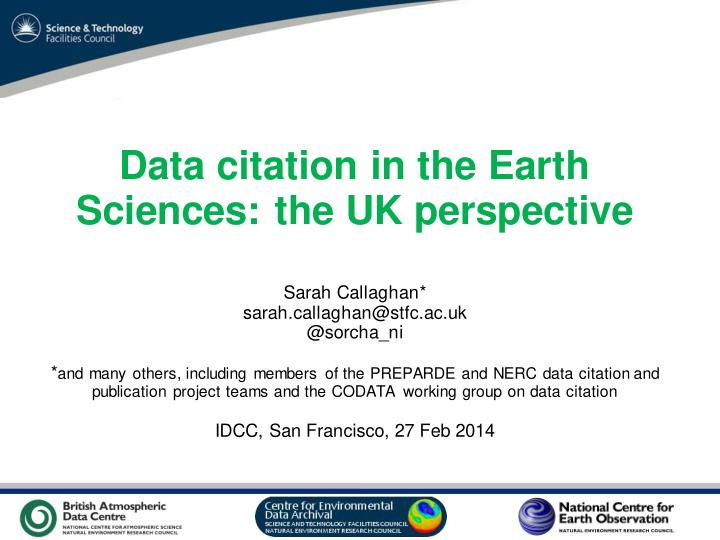



Data citation in the Earth Sciences: the UK perspective Sarah Callaghan* sarah.callaghan@stfc.ac.uk @sorcha_ni * and many others, including members of the PREPARDE and NERC data citation and publication project teams and the CODATA working group on data citation IDCC, San Francisco, 27 Feb 2014 VO Sandpit, November 2009
Who are we and why do we care about data? The UK’s Natural Environment Research Council (NERC) funds six data centres which between them have responsibility for the long-term management of NERC's environmental data holdings. We deal with a variety of environmental measurements, along with the results of model simulations in: • Atmospheric science • Earth sciences • Earth observation • Marine Science • Polar Science • T errestrial & freshwater science, Hydrology and Bioinformatics VO Sandpit, November 2009
What types of data do we have? 1. Time series, some still being updated e.g. meteorological measurements 2. Large 4D synthesised datasets, e.g. Climate, Oceanographic, Hydrological and Numerical Weather Prediction model data generated on a supercomputer 3. 2D scans e.g. satellite data, weather radar data 4. 2D snapshots, e.g. cloud camera 5. Traces through a changing medium, e.g. radiosonde launches, aircraft flights, ocean salinity and temperature 6. Datasets consisting of data from multiple instruments as part of the same measurement campaign 7. Physical samples, e.g. fossils VO Sandpit, November 2009
How we (NERC) cite data • The NERC data centres have the ability to mint DOIs and assign them to datasets in their archives. We have also produced: • guidelines for the data centre on what is an appropriate dataset to cite • guidelines for data providers about data citation and the sort of datasets we will cite • text in the NERC grants handbook telling grant applicants about data citation • NERC held datasets have been published in data journals and cited in papers. • Still plenty of work to do! Not just mechanical processes (e.g. workflows, guidelines) but also changing the culture so that citing and publishing data is the norm. NERC’s guidance on citing data and assigning DOIs can be found at: http://www.nerc.ac.uk/research/sites/data/doi.asp VO Sandpit, November 2009
What sort of data can we/will we assign a DOI to? Dataset has to be: • Stable (i.e. not going to be modified) • Complete (i.e. not going to be updated) • Permanent – by assigning a DOI we’re committing to make the dataset available for posterity • Good quality – by assigning a DOI we’re giving it our data centre stamp of approval, saying that it’s complete and all the metadata is available When a dataset is cited that means: • There will be bitwise fixity • With no additions or deletions of files • No changes to the directory structure in the dataset “bundle” A DOI should point to a html representation of some record which describes a data object – i.e. a landing page. Upgrades to versions of data formats will result in new editions of datasets. VO Sandpit, November 2009
Dataset catalogue page (and DOI landing page) Dataset citation Clickable link to Dataset in the archive VO Sandpit, November 2009
Another example of a cited dataset VO Sandpit, November 2009
What we’ve done and how we’ve done it Doi:10232/123ro Data paper has been published in a data 2. journal, linked via DOI to underlying Publication of data sets dataset. Formal citations of datasets (Journal publishers) (also using DOIs) done in standard academic articles. Can cite using URLs, but we’ve realised that people don’t trust URLs. We’re Doi:10232/123 1. loading DOIs with more meaning than Data Set Citation them simply being a persistent identifier – using them to signify completeness (Everyone!) and technical quality of the dataset. We’re also looking at citation counts as metric for dataset impact. 0. The day job – take in data and metadata Serving of data sets supplied by scientists (often on a on- (Data centres) going basis). Make sure that there is adequate metadata and that the data files are appropriate format. Make it available to other interested parties. VO Sandpit, November 2009
Recommend
More recommend